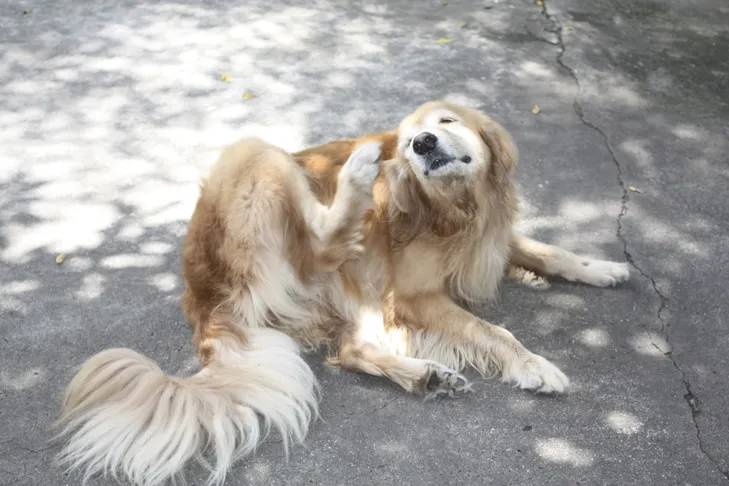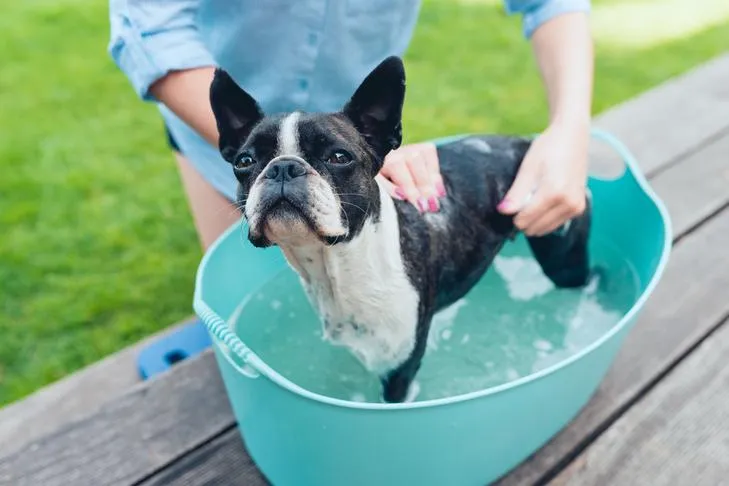Discovering parasites on your beloved dog can be alarming, and a common first concern for many pet owners is whether these unwelcome guests can transfer to human family members. When it comes to lice, the good news offers immediate reassurance: no, dog lice are not the same as human lice, and they cannot spread from your canine companion to you, nor vice-versa. This species-specific nature is a critical distinction that can ease a lot of worry.
However, while you and your family are safe from canine lice, an infestation is still a serious issue for your dog. Like fleas, lice can cause significant discomfort, leading to intense itching, inflammation, hair loss, and even more severe health complications if left untreated. Understanding dog lice – what they are, how to identify them, and effective treatment strategies – is essential for any responsible pet owner to ensure their dog’s health and well-being. This guide will clarify the differences between dog and human lice and provide comprehensive information to help you manage and prevent canine infestations.
The Species-Specific Nature of Lice: A Key Difference
The fundamental reason why Is Dog Lice The Same As Human Lice is always met with a resounding “no” lies in their biological design: lice are strictly species-specific parasites. This means that a particular species of louse is adapted to live and feed exclusively on one type of host animal. The microscopic structure of their claws, for instance, is perfectly tailored to grip the hair shafts of their specific host. If a dog louse were to land on a human, its claws wouldn’t be able to hold onto human hair effectively, making it impossible for them to establish an infestation. Similarly, human head lice ( Pediculus humanus capitis) cannot survive or reproduce on dogs.
This biological specificity means that while a louse might briefly land on a non-host, it won’t be able to feed, reproduce, or survive for long. For dog owners, this is a huge relief, as it eliminates the worry of cross-infestation between pets and people. However, it doesn’t diminish the need for prompt action if you suspect your dog has lice. You can read more about specific parasitic concerns in pets and their human transmission risks, such as whether ear mites in dogs can humans get it.
What Exactly Are Dog Lice?
Lice that infest dogs are small, flat, wingless, six-legged insects. They are obligate parasites, meaning they must live on a host to survive. Their strong, hook-like claws at the end of each leg are perfectly designed to cling tightly to the dog’s hair shafts. Lice survive by feeding on skin debris, sebaceous secretions (oils produced by the skin), or the blood of their host animal.
There are two primary types of lice that affect dogs:
Chewing Lice (Mallophaga)
Chewing lice, also known as biting lice, have a blunt, flat head and survive by eating skin debris and surface secretions. The two species commonly affecting dogs and wild canids are Trichodectes canis and Heterodoxus spiniger. T. canis is found worldwide and typically has a life cycle of about 30 days on a host. H. spiniger is more prevalent in tropical regions, though it has been observed on coyotes, red foxes, and gray wolves in North America, and has been documented on domestic dogs in areas like southeastern Mexico.
Sucking Lice (Anoplura)
Sucking lice, in contrast, need blood to survive and possess a sharp, pointed mouthpiece designed for piercing the skin. The species of sucking lice that affects dogs is Linognathus setosus. These parasites are widespread in tropical and subtropical areas across various continents, including North and South America, Africa, India, and Asia. Sucking lice can cause more severe irritation and health issues due to their blood-feeding habits.
 Golden Retriever dog intensely scratching its head outdoors due to a possible lice infestation, highlighting common dog lice symptoms.
Golden Retriever dog intensely scratching its head outdoors due to a possible lice infestation, highlighting common dog lice symptoms.
Recognizing the Signs: How to Spot Dog Lice
Spotting a dog lice infestation often requires a keen eye, as the parasites can be mistaken for other common skin issues like dandruff or even fleas. Adult lice are roughly the size of a sesame seed (about 2-4 millimeters) and are typically visible to the naked eye. Their color ranges from yellow to tan or medium brown. You can often see them by carefully parting your dog’s hair and examining the hair shafts. They are distinguishable from fleas, which are much darker, almost black, and move with incredible speed.
Chewing lice tend to move around more on the dog’s coat, whereas sucking lice, much like ticks, embed their piercing mouthparts into the skin to feed. If you suspect an infestation, running a fine-toothed flea comb through your dog’s fur can help dislodge and reveal the parasites. After combing, examine the collected debris closely.
One common mistake dog owners make is confusing lice eggs, known as nits, with dandruff. Nits are tiny, yellowish-white oval specs firmly glued to the hair shafts, often near the skin. To tell the difference, try to remove the flakes or specs from a piece of removed hair. If they fall off easily, it’s likely dandruff. If they cling stubbornly, it’s probably nits.
Other signs that your dog may have a lice infestation include:
- Intense scratching and itchiness: This is often the most noticeable symptom, as the parasites irritate the skin.
- Rough, dry, or matted coat: The constant scratching and the presence of lice can degrade the quality of the dog’s fur.
- Hair loss: Especially noticeable around the ears, neck, shoulders, groin, and rectal regions due to excessive scratching and biting.
- Small wounds or bacterial infections: These can result from the bites of sucking lice or from the dog’s self-inflicted scratching, which can break the skin.
- Restless behavior: A dog infested with lice may seem agitated or unable to settle down due to constant irritation.
- Anemia: In severe cases, particularly in small dogs, puppies, or immunocompromised animals, heavy infestations of blood-sucking lice can lead to anemia.
- Secondary parasites or infections: Lice can sometimes transmit other issues, such as tapeworms, if ingested by the dog during grooming. This is different from more serious internal parasites like heartworms; understanding symptoms of heartworms in dogs and cats is also vital for pet owners. If you’re observing skin issues, it’s also worth distinguishing from signs and symptoms of ear mites in dogs.
 Standard Schnauzer puppy scratching its side vigorously in the grass, a key indicator of dog lice or other skin irritations.
Standard Schnauzer puppy scratching its side vigorously in the grass, a key indicator of dog lice or other skin irritations.
How Dogs Contract Lice: Understanding Transmission
Unlike fleas, which can jump, or flies, which can fly, lice have very limited mobility. They can crawl, but they are unable to jump, hop, or fly, which restricts how they move from one host to another. Furthermore, adult lice cannot survive for long off a host, typically dying within a few days if they fall off.
Transmission of lice usually occurs through direct contact with another infested animal. This is why environments where dogs congregate are higher risk areas. These include dog daycare centers, boarding kennels, dog parks, or even during casual interactions with other dogs.
Beyond direct contact, lice can also be passed on through contaminated inanimate objects. This includes shared bedding, dog collars, leashes, grooming tools (brushes, combs), or any surface an infested dog frequently uses.
The life cycle of a louse consists of three main stages: egg, nymph, and adult.
- Eggs (Nits): The cycle begins when the female louse lays tiny, yellowish-white eggs, known as nits. These are meticulously glued to the base of the dog’s hair shafts, making them incredibly difficult to dislodge, even with shampooing.
- Nymphs: Approximately one week after being laid, the nits hatch, releasing immature lice called nymphs. These nymphs are no larger than the head of a pin and begin feeding immediately.
- Adults: After about one week and several molts, the nymphs develop into the adult phase, completing their maturation and becoming reproductively capable. According to the Merck Veterinary Manual, it generally takes about 3 to 4 weeks for most lice species to go from a nit to a fully mature, reproducing adult. The cycle then starts all over again.
Understanding this life cycle is crucial for effective treatment, as many treatments target adult lice but not the resilient eggs.
Effective Treatment and Prevention Strategies for Dog Lice
Fortunately, with advancements in veterinary care and pet products, lice infestations have become less common among well-cared-for domestic dogs. The widespread use of monthly flea and tick preventives has significantly reduced the prevalence of lice. Today, infestations are more frequently observed in animals that are old, sick, stray, feral, or living in unsanitary conditions.
If your dog does become infested, prompt and thorough treatment is essential:
- Clipping and Combing: For dogs with severe infestations, especially those with matted hair, clipping the affected fur may be necessary. Lice and their eggs often cling stubbornly to matted hair and can be challenging to remove otherwise. A fine-toothed flea comb can then be used to physically remove live lice and nits from the rest of the coat. After each use, immerse the flea comb in hot water mixed with a flea shampoo or other insecticide for at least 10 minutes to kill any remaining parasites.
- Insecticide Treatments: Various insecticides are highly effective against dog lice. Common active ingredients include Fipronil, imidacloprid, and selamectin, often found in topical spot-on treatments. Topical permethrin can also be effective. It is crucial to always consult your veterinarian before applying any product. Dr. Jerry Klein, AKC Chief Veterinarian, emphasizes, “Always ask your veterinarian about what products are safe to use on your dog based on his health, breed, and age.” Additionally, be extremely cautious if you have cats in your household, as many dog-specific insecticides, particularly those containing permethrin, are highly toxic to felines.
- Repeat Treatments: Most topical or shampoo-based insecticide treatments will kill adult lice and nymphs but are not effective against the eggs (nits). Therefore, treatments must be repeated at regular intervals, typically over one month or more, to kill newly hatched nymphs before they can lay new eggs. Your veterinarian will advise on the specific schedule.
- Treating All Pets: In a multi-dog household, it is imperative to treat all dogs, even if only one appears to be infested, to prevent reinfestation.
- Environmental Sanitization: Lice can survive for a short period off the host, and nits can remain on bedding or grooming tools. To prevent reinfestation, thoroughly wash all dog bedding, sweaters, leashes, and collars in hot water. Clean and vacuum all areas where your dogs spend time, such as crates, furniture, and carpets. Some veterinarians even recommend replacing grooming tools entirely, as removing the sticky eggs from combs and brushes can be very difficult. An infested dog and their bedding should be kept separate from other animals for at least four weeks after treatment.
 Boston Terrier dog being bathed in an outdoor tub, a crucial step in treating and preventing dog lice infestations.
Boston Terrier dog being bathed in an outdoor tub, a crucial step in treating and preventing dog lice infestations.
Long-term prevention of lice infestations involves maintaining your dog’s overall health and living conditions. Providing good nutrition, regular grooming, and a clean living environment will bolster your dog’s immune system and make them less susceptible to parasites. If you are ever unsure about any aspect of your dog’s health or parasite prevention, always consult with your veterinarian.
Conclusion
Understanding that is dog lice the same as human lice is a question with a clear answer – no, they are not – should provide pet owners with significant peace of mind regarding cross-species transmission. While dog lice pose no threat to humans, they are a serious health concern for canines, causing discomfort, skin irritation, and potential secondary issues. Recognizing the signs of an infestation, understanding how lice spread, and implementing effective treatment and prevention strategies are crucial steps for every dog owner.
Early detection and prompt veterinary intervention are key to successfully eradicating lice and restoring your dog’s comfort and health. By combining regular parasite prevention, good hygiene, and a keen eye for symptoms, you can protect your beloved companion from these irritating pests. Always consult your veterinarian for the safest and most effective treatment plan tailored to your dog’s specific needs. For more expert advice on maintaining your dog’s health and wellness, explore additional resources on Dog Care Story.
References
- Merck Veterinary Manual. (n.d.). Lice of Dogs. Retrieved from https://www.merckvetmanual.com/dog-owners/skin-disorders-of-dogs/lice-of-dogs
- American Kennel Club. (n.d.). Ask AKC: Dr. Jerry Klein. Retrieved from https://www.akc.org/expert-advice/health/
- Florida State University, Molecular Expressions Microscopy Primer. (n.d.). Trichodectes canis. Retrieved from http://micro.magnet.fsu.edu/optics/olympusmicd/galleries/brightfield/trichodectescanis.html
- BioOne. (2017). First Report of Chewing Lice Heterodoxus spiniger (Enderlein, 1909) and Trichodectes canis (De Geer, 1778) on Domestic Dogs (Canis familiaris) from Southeastern Mexico. Southwestern Entomologist, 42(2), 579-586. Retrieved from https://bioone.org/journals/southwestern-entomologist/volume-42/issue-2/059.042.0211/First-Report-of-Chewing-Lice-Heterodoxus-spiniger-Enderlein-1909-and/10.3958/059.042.0211.full
